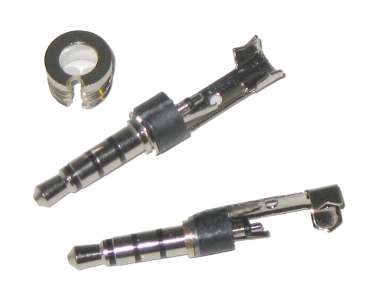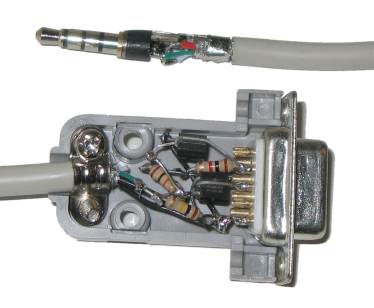Build a Data Cable for the Yaesu VX-6
With 900 channel memories (plus several dozen special purpose saved frequencies) you could wear the printing off of the the VX-6's buttons before you ran out of space. The user interface is nice to have in case you're ever stranded on a desert island with several repeaters, but it's much more practical to program the radio with a computer. The advanced features like alphanumeric naming and the ability to put each memory in any set of banks are great, but incredibly fiddly to access from the keypad.
My main reason for putting up this page, and possibly the only thing you haven't figured out for yourself already, is to tell you that the only known supplier of the special 4-conductor 3.5mm plugs you need is Mouser (there's a link on the left that may take you straight to part 171-7435, Kobiconn 3.5MM 4 COND PLUG).
Machining the Connector
The secondary reason is to show you what you need to do to the plug to make it work with the VX-6's special, deeply-recessed jack. Since I know you have the Kobiconn connector, we can talk specifics:

- On the upper left you see I've slitted the threaded part of the connector. This is just a pressfit, and you might also be able to remove it with an arbor press. Once I had a notch I just popped it loose by twisting a flat screwdriver in the gap.
- You're left with the version in the middle. If you try to insert that in the radio, it will go part way in, but spring back out. Looking back from the tip you'll see a small ring right at the base, which was flush with the threaded ring before it was removed. That's the approximate diameter you'll need to grind the rest of the plug to in order to fit in the VX-6's jack.
- Once your connector looks like the version on the bottom, test fit it in the VX-6. The ring around the socket will come up to about the middle of the solder point for the "tip" connector. I even rounded off the ground/stress relief metallic part, but be careful not to cut through it!
Building the Cable
I started with this two-MOSFET schematic for the adapter. I left off the non-Yaesu part entirely, and built it ugly-style right onto the back of a DB9:

I expected this cable to echo back anything I sent to it, so I tried to test it that way. In fact it doesn't (possibly due to the abuse of pin 7 as a power supply requiring special port settings) but the cable does work with the radio.
I also connected the mic and speaker on the plug side, but you don't need to do that for the data cable. Some day I might fork the audio part off and make a more general-purpose computer connector for the VX-6. The four-conductor shielded cord is cannibalized from a USB extension cable (don't worry, it was only a few dollars).
Software
There is programming software by KC8UNJ which will work with this cable. It may also work with Yaesu's own software. If you want to roll your own, I ran across some protocol information for the VX-7 which might be relevant to the VX-6 as well.
Jon K Hellan sent me mail about his reverse-engineering work on the VX-6 protocol.
